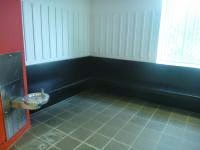The Entrance
 |
| Grand-Opening |
While
the SWAMP is the object of the project, even the entrance to the SWAMP can
emotionally impact the success of the room ahead. As you peer, your reflection
and that of nature rebounds from the door. You have a glimpse into what is ahead
of you.
 |
| Cabinet-of-Learning |
The entrance to the SWAMP waiting area has a cabinet of surprises.
Why this is important is that the cabinet contains useful teaching and learning
experiences of other teachers. This becomes a tool to stimulate their senses
and think of innovative ways, that they can use to engage their students.
Moreover, the selection of teaching aids in the cabinet uses different lines
and curves of objects to create visual effect. This in its self can change the
rhythm of the local atmosphere and change the mood of the seer.
 |
| Sit-Meet-Think |
Finally, the entrance to the SWAMP provides a well-constructed
meeting place before the students enter the computer and lecturer lab. People
need time to bond. Chatter may be meaningfully or not, but an opportunity to
greet each other and discuss what is or what will be done soon, is a necessary
social tool, in bonding human participation and respect. As you can witness
from the picture there is amble seating, light and standing room. While some designers may dismiss the need for
a waiting area, research does show that a group of people in such a setting can
have positive effects. This is based on
the concept of social facilitation theory (Baker & Cameron, 1996). The
concept is that the ‘mere physical presence of others… increase one general
drive level’ (Baker & Cameron, 1996, p.345). Increased drive motivates the
individual in positive behaviour, feeling and upbeat mood swings. Just what is
needed for a class of students, and more beneficial than a gulp of caffeine!
References:
Baker, J. and M. Cameron (1996), "The effects of the service environment on affect and consumer perception of waiting time: An integrative review and research propositions," Journal of the Academy of Marketing Science, 24 (4), 338-349.
No comments:
Post a Comment